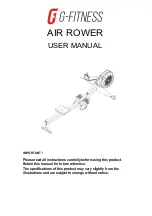
3)76:,1*
*%
0HDVXUHVLQ&DVHRI+RVH2EVWUXFWLRQV3RZHU)DLOXUH
9HUVLRQ
BBBBBBBBBBBBBBBBBBBBBBBBBBBBBBBBBBBBBBBBBBBBBBBBBBBBBBBBBBBBBBBBBBBBBBBBBBBBBBBBBBBBBBBB
________________________________________________________________________________________
:$51,1*
According to the accident prevention regulations of the Bauberufsgenossenschaft
(German trade association having liability for industrial safety and insurance), all
persons who have to remove obstructions are required to wear safety goggles and
stand in a place where they cannot be hit by discharged mortar. Other persons must
not be close to the machine.
*HWWLRVH%ORFNV
-
Briefly rub motor in reverse until the mortar pressure gauge indicates that there is
no pressure
-
Cover the pressure flange with a plastic sheet or similar material
-
Slightly loosen the tie rods of the pressure flange, so that any residual pressure
can be completely eliminated
-
Unscrew the hose coupling
-
Clean the hose
To remove residual mortar, you can:
-
either insert a water hose in the mortar hose
-
or use a long steel rod to push the mortar through the hose or loosen the mortar
0HDVXUHVIRU3RZHU)DLOXUH
The mortar hoses have to be cleaned immediately. This can be done at the water
mains by connecting the mortar hose to the pipe. Push out the mortar by opening the
water valve and then clean the hose with sponge balls soaked in water.
Remove the pump, push the rotor out of the stator and clean them carefully. Then
clean the pump completely, reassemble it and prepare it for operation.
:$51,1*
Before opening the mortar hose couplings, make sure that the mortar hoses are
depressurized. This can be done by reversing the direction of rotation of the pump
motor. The mortar pressure gauge has to read “0”!
















































